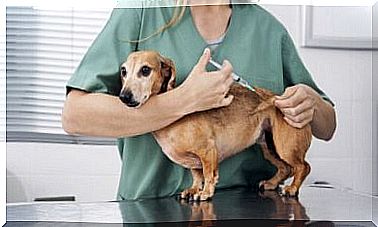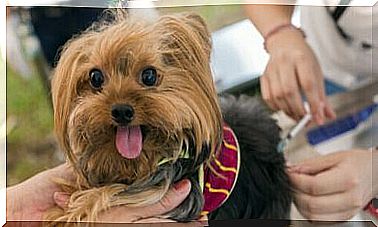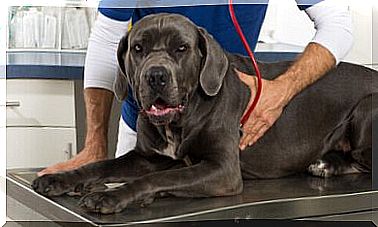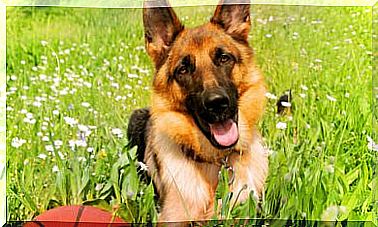What Are The Diseases That Affect Older Dogs?

The inexorable passage of time, to a greater or lesser extent, always leaves marks on organisms. In the case of older dogs, since they have a shorter life expectancy than ours, old age and disease become evident all too soon.
Older dogs have a certain predisposition to suffer from certain diseases that are not common in younger animals. In the following lines we will explain which are these typical pathologies of dogs in the geriatric age.
At what age do dogs get older?
It is important that each guardian knows the age ranges in which his dog can be considered geriatric. Due to the enormous racial diversity that dogs present, the classification is decidedly varied. Generally speaking, we can categorize this species based on weight, according to the following parameters:
- Up to 10 kilos: can be considered senior dogs from 11 years of age.
- Weight between 10 and 30 kilos: this group reaches old age around 9 years.
- Animals over 30 kilos: Large dogs are considered geriatric at a rather early age: only around 7 years old.
These figures are indicative only. In fact, it will be the veterinarian who will tell you at what age the animal can be considered elderly. Of course, some factors intrinsic to the dog (such as the presence of genetic diseases) can lead to upsets in these general limits. Once this question is cleared up, it is time to list the most common diseases in this group.

Cardiovascular diseases
The heart is the body’s clock and, with its beat, marks the rhythm of our life. Over the years, it works tirelessly for millions of contractions. This is why we are not surprised by the idea that it can be one of the organs that are most affected in older dogs.
In addition, the arteries and veins through which blood flow circulates also suffer damage over the years. The walls lose elasticity and deposits of fatty substances are created, among many other events responsible for the aging of the circulatory system.
All this makes the appearance of this type of disease more frequent in geriatric patients. Among the most common cardiovascular diseases associated with age, we find the following:
- Disorders of the valves, particularly the mitral valve. This is the so-called “heart murmur”.
- Thromboembolism or, in other words, clots that clog veins or arteries.
- Hypertension.
- Dilated myocardiopathy (weakening of the heart muscle). Most common in large breed dogs.
Osteoarticular Disorders in Older Dogs
The musculoskeletal system is the mechanism that moves the entire body and it too suffers the ailments due to the passage of time. This is why diseases of this kind are more common in older dogs, especially large breed dogs. The reason is that their large size causes greater bone wear.
Among the most frequent processes, we can mention the following:
- Arthrosis, undoubtedly the most frequent. It affects a large number of older dogs.
- Increased risk of suffering fractures or cracks.
- Disc hernias or protrusions. They can affect young dogs, but are more common in older ones.
- Loss of teething and dental disease.
Neurological problems
The nervous system is one of the most affected systems in older dogs because neurons require a high energy requirement. This characteristic increases their propensity to suffer from degeneration due to oxidative damage, the result of this accelerated metabolism.
The most common neurological diseases in older dogs are the following:
- Cognitive dysfunction syndrome. It equates to a kind of canine Alzheimer’s disease.
- Geriatric vestibular syndrome.
- Epilepsy. It also affects young dogs, but is more common in those of geriatric age.
Hormonal diseases
Organic homeostasis works thanks to a very delicate balance, in which a multiplicity of factors are involved. Old age predisposes to suffer from some pathological processes which, on the other hand, are quite rare in young animals.
Usually, hormone-associated diseases appear slowly and insidiously. We are talking about pathologies such as the following:
- Hypothyroidism.
- Diabetes.
- Kidney failure. It affects a large number of older dogs.
In addition, there is another set of conditions that can make the last few years of life for some older dogs more difficult. For example, age-typical lowering of defenses makes them more vulnerable to contagious infectious diseases.
Equally frequent are the problems affecting the sense organs. Eye disorders, such as cataracts or glaucoma, as well as hearing loss, often occur in older dogs.

As we have seen, there are many and varied diseases that can affect older animals. This is why it is of fundamental importance to intensify veterinary checks in geriatric dogs. In this way, these diseases can be identified early and be adequately treated.








